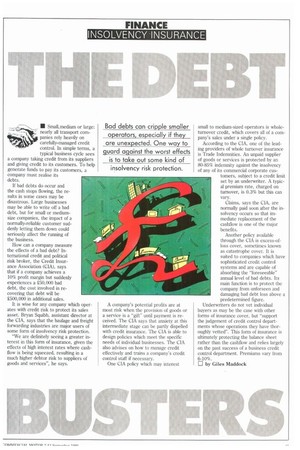• Small, medium or large: nearly all transport companies rely
Page 47

If you've noticed an error in this article please click here to report it so we can fix it.
heavily on carefully-managed credit control. In simple terms, a typical business cycle sees a company taking credit from its suppliers and giving credit to its customers. To help generate funds to pay its customers, a company must realise its debts.
If bad debts do occur and the cash stops flowing, the results in some cases may be disastrous. Large businesses may be able to write off a bad debt, but for small or mediumsize companies, the impact of a normally-reliable customer suddenly letting them down could seriously affect the running of the business.
How can a company measure the effects of a bad debt? International credit and political risk broker, the Credit Insurance Association (CIA), says that if a company achieves a 10% profit margin but suddenly experiences a £50,000 bad debt, the cost involved in recovering that debt will be £500,000 in additional sales.
It is wise for any company which operates with credit risk to protect its sales asset. Bryan Squibb, assistant director at the CIA, says that the haulage and freight forwarding industries are major users of some form of insolvency risk protection.
"We are definitely seeing a greater interest in this form of insurance, given the effects of high interest rates where cashflow is being squeezed, resulting in a much higher debtor risk to suppliers of goods and services", he says.
Bad debts can cripple smaller operators, especially if they are unexpected. One way to guard against the worst effects is to take out some kind of insolvency risk protection.
A company's potential profits are at most risk when the provision of goods or a service is a "gift" until payment is received. The CIA says that anxiety at this intermediate stage can be partly dispelled with credit insurance. The CIA is able to design policies which meet the specific needs of individual businesses. The CIA also advises on how to manage credit effectively and trains a company's credit control staff if necessary.
One CIA policy which may interest small to medium-sized operators is wholeturnover credit, which covers all of a company's sales under a single policy.
According to the CIA, one of the leading providers of whole turnover insurance is Trade Indemnities. An unpaid supplier of goods or services is protected by an 80-85% indemnity against the insolvency of any of its commercial corporate customers, subject to a credit limit set by an underwriter. A typical premium rate, charged on turnover, is 0.3% but this can vary.
Claims, says the CIA, are normally paid soon after the insolvency occurs so that immediate replacement of the cashflow is one of the major benefits.
Another policy available through the CIA is excess-ofloss cover, sometimes known as catastrophe cover. It is suited to companies which have sophisticated credit control systems and are capable of absorbing the "foreseeable" annual level of bad debts. Its main function is to protect the company from unforseen and damaging bad debt loss above a predetermined figure.
Underwriters do not vet individual buyers as may be the case with other forms of insurance cover, but "support the judgement of credit control departments whose operations they have thoroughly vetted". This form of insurance is ultimately protecting the balance sheet rather than the cashflow and relies largely on the past success of a business credit control department. Premiums vary from 6-10%.
by Giles Maddock




















































































































